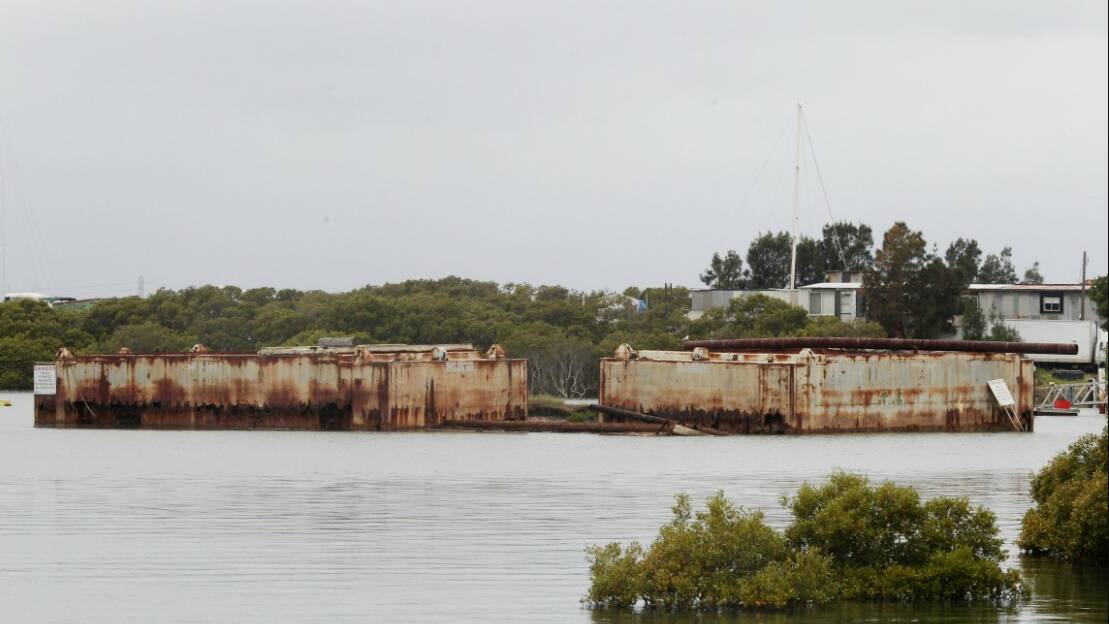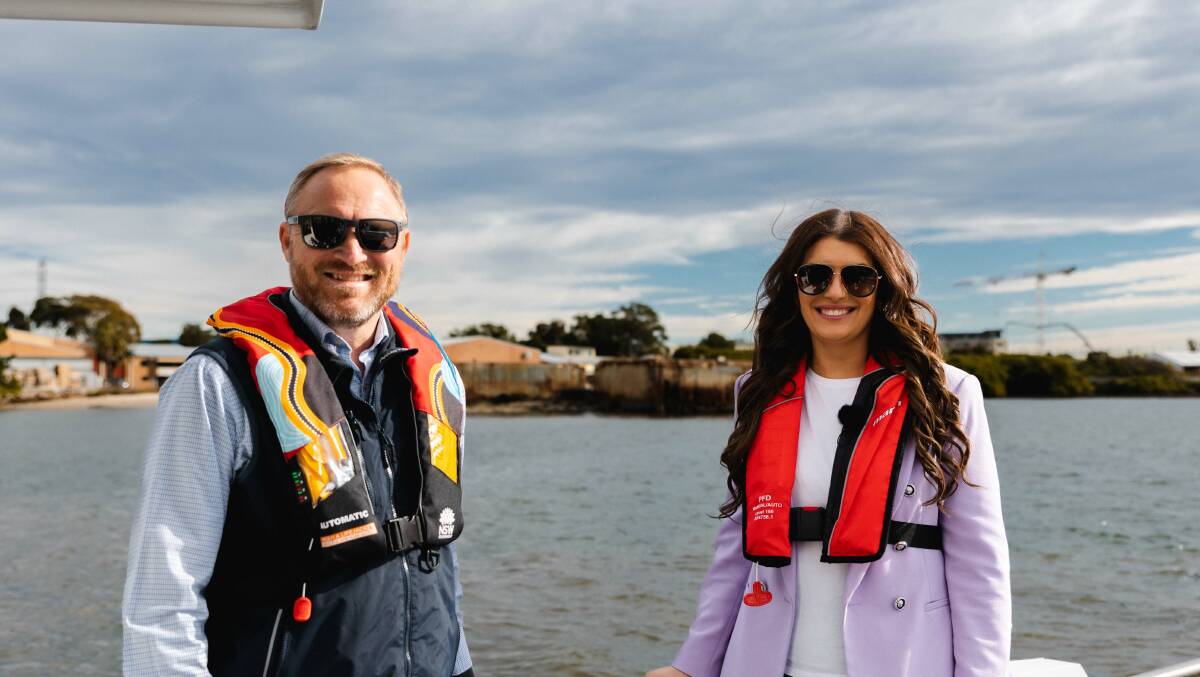Birdlife experts are divided on whether three abandoned barges in Taren Point Shorebird Reserve should be removed.
Create a free account to read this article
$0/
(min cost $0)
or signup to continue reading
Phil Straw, a committee member of the Australasian Wader Studies Group and is a world authority on the subject, has taken a contrary view to other experts whose views have been previously reported.
Mr Straw said shorebirds had alternative sites to the barges.
"Grey-tailed Tattlers also use a nearby wooden jetty if disturbed or displaced from the barges," he said.
"Grey-tailed Tattlers are one of three species in the bay that also readily roost in mangrove trees, including Terek Sandpipers and Whimbrel.
"The small number of Pied Oystercatchers that occasionally use the barges are part of roosting at Spit Island (currently more than 100, the largest number ever counted in the bay)."
Mr Straw said it was planned to reconstruct the sand island - previously a popular shorebirds' roosting area - which was destroyed when the barges were dumped on it.
Earlier
The imminent removal of three abandoned barges in the Taren Point Shorebird Reserve threatens the survival in Botany Bay of rare migratory shorebirds, which fly from the Arctic each year, shorebird experts say.
They question the state government decision to spend $700,000 removing the barges, which are a roosting area for several species, and the apparent urgency when the barges have been there for more than 30 years.
Miranda MP and Minister for Small Business and Fair Trading, Eleni Petinos, announced the move e this week, saying the project by Transport for NSW would improve safety for recreational and commercial waterway users.
Ms Petinos said local environmental factors had been considered, and the Australasian Wader Study Group had been consulted.
The MP's statement shocked Debbie Andrew, of Oatley, a retired zoologist from the NSW National Parks and Wildlife Service and Office of Environment and Heritage, who has been surveying shorebirds in Botany Bay as a professional and a member of the NSW Wader Study Group for more than 30 years.
Ms Andrew, who has also been a member for more than 40 years of the Australasian Wader Study Group, has continued monthly shorebird counts of Botany Bay since her retirement.
"Twenty years of monthly shorebird counts clearly demonstrate the barges are the preferred roosting site of the Grey-tailed Tattler in Botany Bay and rightly so as the structures provide the most secure, protected roost site near their feeding grounds.
"The unidentified commentator from the Australasian Wader Study Group may not have been aware of this information or be familiar with the site.
"The barges are also used as a roost site by the threatened Pied and Sooty Oystercatcher.
"I was not contacted by any of the parties involved in this proposal to provide information or comment.
"The Review of Environmental Factors for this project was not made available to the public for comment.
"Migratory shorebirds have enough threats to cope in their complex migratory lifestyle without us adding extra unnecessary pressures."
Ms Andrew said the predator proof, high tide roosting habitat was the only site in Botany Bay where the Grey-tailed Tattler was regularly recorded.

"The Grey-tailed Tattler is an important member of the Taren Point Shorebird Endangered Ecological Community, protected under state and federal threatened species legislation, and removal of the barges will remove critical habitat," she said.
"Unfortunately, the new artificial island at Taren Point has not succeeded in attracting migratory shorebirds has become a breeding site for Silver Gull and a roost for Australian Pelican.
"The $700,000 price tag to undertake this destructive, unnecessary action should be re-directed to restore Towra Spit Island in the internationally listed Towra Point Nature Reserve, which provides the major high tide roost for migratory shorebirds in Botany Bay and which after every east coast storm event becomes even smaller until it will ultimately disappear.
"Sadly, no action has been taken by government to protect this critical migratory shorebird habitat."
Dr Steve Klose, migratory shorebird program manager for the Australasian Wader Studies Group, said, "Migratory shorebirds such as Grey-tailed Tattlers will take to man-made structures such as the abandoned barges at Taren Point where people, dogs, cats, and foxes cannot reach them when they are out of options, as a last resort.
"The barges appear to have been there for three decades and have provided high tide roosting for shorebirds, so the questions are: Do they really need to be removed, why are the birds here and not elsewhere and what are the reasons newly created habitat has not been accepted - is the alternative really suitable for this species?
"Habitat is key, without it, the birds can't survive, so making sure the alternatives provided are really working is critical."
Dr Klose said migratory shorebirds that flew from the Arctic every year to spend the northern winter in warmer regions were threatened and had been in decline for decades.
"One of the key issues is safe roosting and feeding places free from disturbances," he said.
"Every short flight costs energy, and if a bird the size of a Tim Tam (smallest of our species) flies all the way back to Siberia, they need all the energy they can hold on to.
Often, especially in urban environments, there are not enough safe and suitable places to go."
Dr Klose said restoration of the slowly degrading Towra Spit Island in Towra Point Nature Reserve (a site under the Ramsar Convention covering internationally significant wetlands), which was known to provide a high tide roost for migratory shorebirds, "seems to be great starting point, and shorebirds would greatly benefit from investment here".
"Towra Spit has been degrading for a number of years and it is worrying to see habitat lost in an important area in multiple places," he said.
Dr Klose said there appeared "little benefit for a lot of money being spent to remove a safe roost while other roosting areas are under pressure and get smaller at the same time"
Work will start this month to remove three abandoned barges, which have been rusting away in the water at Taren Point for more than 30 years.
Miranda MP and Minister for Small Business and Fair Trading, Eleni Petinos, said the state government had committed more than $700,000 to the project.
Ms Petinos said the project by Transport for NSW to demolish and remove the barges would improve the safety for recreational and commercial waterway users," she said.
"The aim is to create a safe environment for the community to enjoy our beautiful waterway, while also considering local environmental factors," she said.

"There are several benefits to the removal and demolition of the barges including mitigating safety risks for maritime users, reducing pollution in Woolooware Bay and providing a safer environment for migratory birds."
"As the three barges are currently located within the Taren Point Migratory Shorebird Reserve, it was important to ensure the project would not have a significant impact on roosting and migration periods for endangered migratory birds."
"There are other nearby locations suitable for roosting including the dedicated shorebird and wader roosting island that the Sutherland Shire Council recently constructed approximately 250 metres northwest of the site.
"The Australasian Wader Study Group was consulted and advised that the demolition and removal of these barges should be carried out in the winter months when the birds migrate away from the area."
The project is expected to be completed by the end of August.


